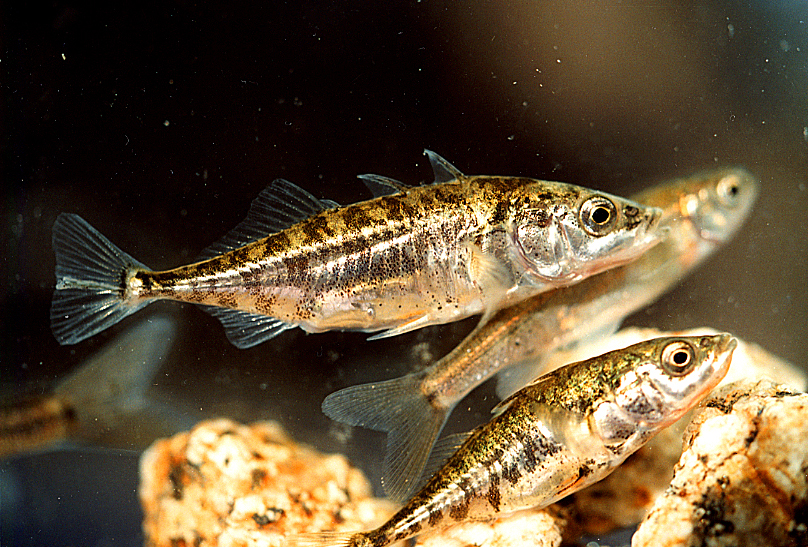
Proximo Hi-C genome scaffolding not only improved the well-studied threespine stickleback assembly, but also found structural differences that would have otherwise been missed.
This week researchers from the University of Bern and the University of Georgia released a new high-quality reference threespine stickleback genome. The results of this project, a joint collaboration between Dr. Catherine Peichel, Dr. Michael White, and Phase Genomics, were publiaried in the Journal of Heredity. By applying a relatively new scaffolding technology, Proximo Hi-C, the team was able place 60% of previously unassigned sequence to chromosomes. These previously unplaced sequences make up ~5% (13 Megabases) of the stickleback genome and contain multiple genes and other functional DNA. The assembly was generated from an individual from a different lake than the previous stickleback reference genome, and the structural information generated by Proximo Hi-C allowed the team to identify novel structural variants between the two populations. These improvements and new structural information will benefit many research groups that use this model organism to study genetics and evolution.
The first efforts to sequence and assemble the threespine stickleback genome from 2012 used a costly sequencing method called Sanger sequencing. This assembly was followed by two revisions in 2013 and 2015 that used standard short-read sequencing technologies. Short reads can be assembled together into larger fragments of the genome called contigs, but some regions of the genome are difficult to assemble because they are long, highly repetitive, or otherwise ambiguous. In the end, these efforts left researchers with a decent yet highly fragmented picture of the stickleback’s chromosomes, with other large portions of its genetic sequence left in individual contigs unassociated to any chromosome.

Dr. Catherine (Katie) Peichel (left), Head of the Division Evolutionary Ecology, University of Bern, and Dr. Michael White, Assistant Professor, Department of Genetics, University of Georgia, used Proximo Hi-C genome scaffolding to make many improvements to the Threespine stickleback genome and detect structural variation.
Dr. Peichel and Dr. White used Phase Genomics’ Proximo Hi-C genome scaffolding technology to resolve many of these issues and create the new reference genome. Proximo Hi-C genome scaffolding uses a protocol called Hi-C to measure the physical structure of an organism’s genome and then uses that information to place contigs into chromosome-scale de novo assemblies. Phase Genomics was founded by the inventors of this genome assembly approach and has been making its Proximo Hi-C genome scaffolding technology available to researchers since 2015. The company specializes in generating and analyzing Hi-C data for the scaffolding of genomes such as the Threespine stickleback, as well as for analyzing microbial communities and other metagenomic samples through its ProxiMeta™ Hi-C metagenomic deconvolution technology.
We know that scientific tools are only as good as the resulting scientific findings. We sent a brief Q&A to both Dr. Peichel and Dr. White to get their take on the scientific value of Proximo Hi-C and share their experiences in working with us.
Why is the stickleback genome important?
Sticklebacks are a “supermodel” for evolutionary genetics, in that they have been one of the leading model systems for identifying the genetic and molecular basis of phenotypic changes in natural populations. Thus, it is important to have a complete genome sequence so that one can correctly identify all the genes that are present in a genomic region that is associated with a phenotype of interest. -CP
Why did the original genome need improvement?
A high-quality Sanger-sequenced genome was published in 2012 and has undergone two revisions since this time. Despite incorporating dense linkage maps to help assign many of the unanchored scaffolds to linkage groups, over 26.7 Mb of the 460 Mb genome still remained unassigned to linkage groups. We needed to apply other approaches to try and assign these remaining scaffolds. -MW
How did Proximo Hi-C scaffolding improve the contiguity of the genome?
We were able to assign over 60% of the unassigned contigs to chromosomes. -CP
What other applications of the Hi-C data are useful to your biological questions?
Hi-C is a useful way to identify structural variation (like inversions) among stickleback populations. We are also excited about the possibility of using Hi-C for assembly of the hard-to-assemble regions of the genome like Y chromosomes. -CP
Why did you choose to work with Phase Genomics?
I was impressed by their interest in our biological questions and dedication to working with us until we were satisfied with the assembly. -CP
We chose to work with Phase Genomics because of the ease of the entire pipeline. Phase Genomics was fast and kept us updated at every step along the way. It was great to work with a group that was so communicative and open to trying different approaches to get the best assembly. -MW
